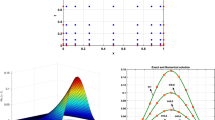Abstract
The paper describes a hybrid symbolic–numeric approach to automation of primal and sensitivity analysis of computational models formulated and solved by finite element method. The necessary apparatus for the automation of steady-state, steady-state coupled, transient and transient coupled problems is introduced as combination of a symbolic system, an automatic differentiation (AD) technique and an automatic code generation. For this purpose the paper extends the classical formulation of AD by additional operators necessary for a high abstract description of primal and sensitivity analysis of the typical computational models. An appropriate abstract description for the fully implicit primal and sensitivity analysis of hyperelastic and elasto-plastic problems and a symbolic input for the generation of necessary user subroutines for the two-dimensional, hyperelastic finite element are presented at the end.
Similar content being viewed by others
References
Amberg G, Tonhardt R, Winkler C (1999) Finite element simulations using symbolic computing. Math Comput Simul 49: 257–274
Bartholomew-Biggs M, Brown S, Christianson B, Dixon L (2000) Automatic differentiation of algorithms. J Comput Appl Math 124(1–2): 171–190
Beall MW, Shephard MS (1999) Object-oriented framework for reliable numerical simulations. Eng Comput 15(1): 61–72
Bischof C, Hovland P, Norris B (2002) Implementation of automatic differentiation tools. In: Norris C, Fenwick JB Proceedings of the ACM SIGPLAN workshop on partial evaluation and semantics-based program manipulation. ACM Press, New York
Bischof CH, Buecker HM, Lang B, Rasch A, Risch JW (2003) Extending the functionality of the general-purpose finite element package SEPRAN by automatic differentiation. Int J Numer Methods Eng 58: 2225–2238
Choi KK, Kim NH (2005) Structural sensitivity analysis and optimization 1, Linear systems. Springer, New York, p 446
Eyheramendy D, Zimmermann Th (1999) Object-oriented symbolic derivation and automatic programming of finite elements in mechanics. Eng Comput 15(1): 12–36
Fritzson P, Fritzson D (1992) The need for high-level programming support in scientific computing applied to mechanical analysis. Comput Struct 45: 387–395
Gonnet G (1986) New results for random determination of equivalence of expression. In: Char BW (ed) Proceedings of 1986 ACM symposium on symbolic and algebraic computation, Waterloo, pp 127–131
Griewank A (2000) Evaluating derivatives: principles and techniques of algorithmic differentiation. SIAM, Philadelphia
Keulen F, Haftka RT, Kim NH (2005) Review of options for structural design sensitivity analysis. Part 1: linear systems. Comput Methods Appl Mech Eng 194: 3213–3243
Kleiber M, Antunez H, Hien TH, Kowalczyk P (1997) Parameter sensitivity in nonlinear mechanics. Wiley, New York
Kirby RC, Knepley M, Logg A, Scott LR (2005) Optimizing the evaluation of finite element matrices. SIAM J Sci Comput 27: 741–758
Korelc J (1997) Automatic generation of finite-element code by simultaneous optimization of expressions. Theor Comput Sci 187: 231–248
Korelc J (2001) Hybrid system for multi-language and multi-environment generation of numerical codes. In: Proceedings of the ISSAC’2001 symposium on symbolic and algebraic computation. ACM Press, New York, pp 209–216
Korelc J (2002) Multi-language and multi-environment generation of nonlinear finite element codes. Eng Comput 18: 312–327
Korelc J (2007) AceGen user manual, http://www.fgg.uni-lj.si/symech/
Michaleris P, Tortorelli DA, Vidal CA (1994) Tangent operators and design sensitivity formulations for transient non-linear coupled problems with applications to elastoplasticity. Int J Numer Methods Eng 37: 2471–2499
Logg A (2007) Automating the finite element method. Arch Comput Methods Eng 14: 93–138
Mathematica 6.0, Wolfram Research Inc., http://www.wolfram.com
Pironneau O, Hecht F, Hyaric A (2008) FreeFem++, ftp://www.freefem.org/
Simo JC, Hughes TJR (1998) Computational inelasticity. Springer, New York
Wang PS (1986) Finger: a symbolic system for automatic generation of numerical programs in finite element analysis. J Symb Comput 2: 305–316
Zienkiewicz OC, Taylor RL (1991) The finite element method, vols I, II. McGraw Hill, New York
Author information
Authors and Affiliations
Corresponding author
Rights and permissions
About this article
Cite this article
Korelc, J. Automation of primal and sensitivity analysis of transient coupled problems. Comput Mech 44, 631–649 (2009). https://doi.org/10.1007/s00466-009-0395-2
Received:
Accepted:
Published:
Issue Date:
DOI: https://doi.org/10.1007/s00466-009-0395-2




